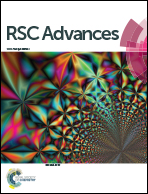Tailored interfacial architecture of chitosan modified glassy carbon electrodes facilitating selective, nanomolar detection of dopamine
Abstract
Herein, it is demonstrated that the sulfonation of chitosan (CS) on a glassy carbon surface (GCE) facilitates the making of a new sensing platform for the selective, nanomolar detection of dopamine. The surface functionalisation of CS was carried out using sulphamic acid (SA) by simple glutaraldehyde (GA) cross-linking to yield the sulfonated derivative (GCE–CS–GA–SA). The sulfonated chitosan possesses sulfonic acid functionalities which provide an electrostatic barrier, thereby discriminating dopamine from ascorbic acid. Electrochemical techniques, branded for their accuracy and fast response, are employed to determine dopamine concentrations down to few nanomoles in the presence of high concentrations of AA. In addition to nanomolar detection, the reported sensing methodology exhibits a low dopamine oxidation potential of 210 mV vs. normal calomel electrode (NCE) and wide linear ranges of 50 nM to 10 μM and 10–400 μM in chronoamperometry and differential pulse voltammetry, respectively. These results reveal that an inexpensive, simple and facile functionalization of chitosan like polymers on carbon surfaces can open up new avenues in the creation of perm-selective membranes that can find application in novel biosensors fabrication, especially in electrophysiology.


 Please wait while we load your content...
Please wait while we load your content...